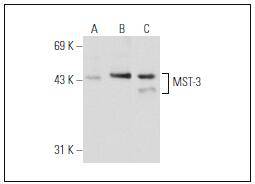Product Detail
Product NameMst3 Antibody
Clone No.1G8
Host SpeciesMouse
ClonalityMonoclonal
PurificationProA affinity purified
ApplicationsWB, IP, IF
Species ReactivityHu, Ms, Rt
Immunogen DescAmino acids 275-393 of MST-3 of human origin.
ConjugateUnconjugated
Other Namesepididymis secretory protein Li 95 antibody HEL-S-95 antibody Mammalian STE20 like protein kinase 3 antibody Mammalian STE20-like protein kinase 3 antibody Mammalian STE20-like protein kinase 3 C-terminal antibody Mammalian STE20-like protein kinase 3 N-terminal antibody Mammalian sterile 20-like 3 antibody MST-3 antibody MST3/C antibody MST3/N antibody MST3B antibody serine threonine kinase 24 antibody Serine/threonine kinase 24 (Ste20, yeast homolog) antibody Serine/threonine-protein kinase 24 12 kDa subunit antibody Serine/threonine-protein kinase 24 antibody STE20 homolog yeast antibody STE20 like kinase MST3 antibody STE20-like kinase MST3 antibody Stk24 antibody STK24_HUMAN antibody STK3 antibody
Accession NoSwiss-Prot#:Q9Y6E0
Uniprot
Q9Y6E0
Gene ID
8428;
Calculated MW50/35 kDa
Formulation1*TBS (pH7.4), 1%BSA, 40%Glycerol. Preservative: 0.05% Sodium Azide.
StorageStore at -20˚C
Application Details
WB: 1:100-1:1,000
IP: 1-2 μg per 100-500 μg of total protein(1 ml of cell lysate)
Western blot analysis of MST-3 expression in non-transfected 293T (A), human MST-3 transfected 293T (B) and A-431 (C) whole cell lysates.
Immunofluorescence staining of HeLa cells showing cytoplasmic staining.
Sterile-20 (STE20) is a serine/threonine kinase in Saccharomyces cerevisiae that is involved in relaying signals from G protein-coupled receptors to cytosolic MAP kinase cascades. Mammalian protein kinases that display sequence similarity to STE20 are divided into two groups, the PAK subfamily and the GCK subfamily. The PAK subfamily members contain a C-terminal catalytic domain and an N-terminal regulatory domain with a p21Rac/Cdc42-binding site, and these kinases can activate both p38 MAPK and JNK. The GCK subfamily members contain a C-terminal regulatory domain and an N-terminal catalytic domain, and they have diverse roles in many pathways, including the activation of ERK, JNK, p38 MAPK, and caspase-3. The mammalian STE20-like kinases (MST kinases, also known as Ksr proteins) are members of the GCK subfamily. Ksr-1 and Ksr-2 (also known as MST-2 and MST-1, respectively) are both direct substrates of caspase-3 that accelerate caspase-3 activation. MST-3 is ubiquitously expressed in mammalian tissue and can phosphorylate exogenous substrates as well as itself. MST-4 is highly expressed in placenta, thymus, and peripheral blood leukocytes, and it specifically activates ERK.
If you have published an article using product 48317, please notify us so that we can cite your literature.




 Yes
Yes



